What to See in Venice
The 22 most beautiful sights in Venice
Latest update: March 6, 2024
In a nutshell: Our 5 Venice highlights
- St. Mark’s Basilica: the huge church with its five domes is definitely worth seeing from the outside and inside.
- Rialto Bridge: the most photographed motif in Venice. The best time to do so is in the late afternoon. The setting sun then shines directly on it.
- St. Mark’s Square: The most famous highlights in Venice are located here. But also the square itself has become a top sight.
- Doge’s Palace: The city was once ruled from here. Today you can visit the magnificent residential quarters.
- Canal Grande: On the widest canal in Venice, there are always countless gondolas, motorboats and ferries.
These are the definitive must-sees in Venice. Find out more about these highlights, other sights and our best tips below.
Buy tickets for the Venice highlights in advance
Venice is one of the most visited destinations in the world. So hours-long lines at the major attractions are pretty much a given.
That’s why it is definitely worth booking tickets in advance for the most famous Venice sights. They allow you to simply skip the line and go head straight for the entrance.
Here’s a list of Venice attractions with skip-the-line tickets available:
| Price per person | Tickets | |
|---|---|---|
| Doge’s Palace | 28 euros | To the ticket |
| Peggy Guggenheim Collection | 19 euros | To the ticket |
| Palazzo Contarini del Bovolo | 8 euros | To the ticket |
Venice sightseeing map
To give you a rough impression of city’s layout, here’s a map with all of Venice’s major sights and attractions.
That way you can see where in Venice which sight is located and you can plan your visit even better.
Click here to download our Venice sightseeing map
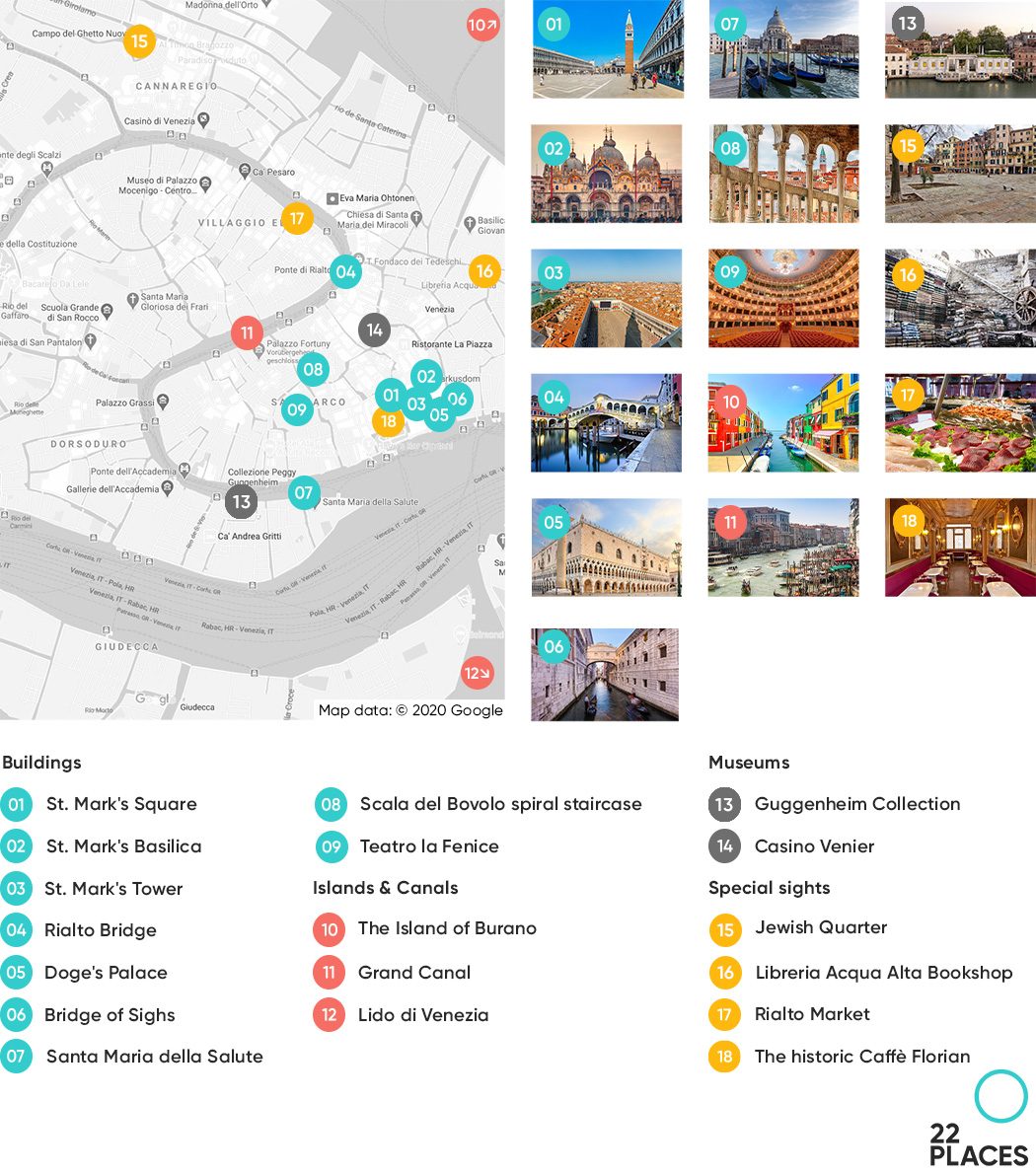
St. Mark's Square
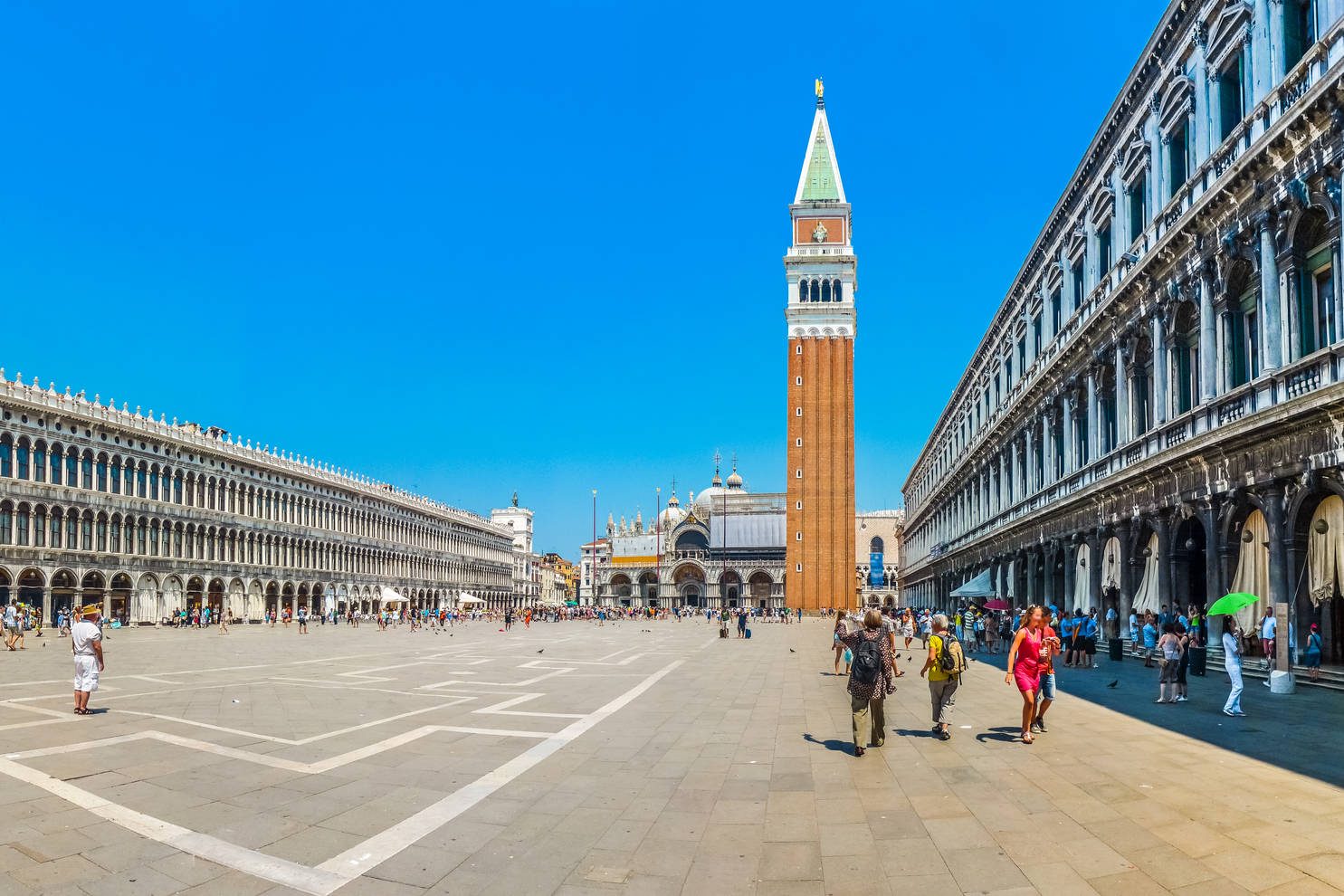
St. Mark’s Square is the most famous square in Venice and is absolute must-see.
The square is huge: to be precise, 175 meters long and 82 meters wide. And it is well-attended at all times of day: by tourists, residents and what feels like thousands of pigeons.
Several of the major Venice sights are located directly in the square: The Doge’s Palace, St. Mark’s Basilica, the slightly leaning St. Mark’s Tower, the Procuraties, Venice’s former government buildings, and the historic Caffé Florian.
The other side ends on the open water. A real feast for the eyes! The square is only a few meters above sea level, so sometime it’s underwater in winter. In that case, footbridges are installed on the square so visitors can still come here.
St. Mark's Basilica
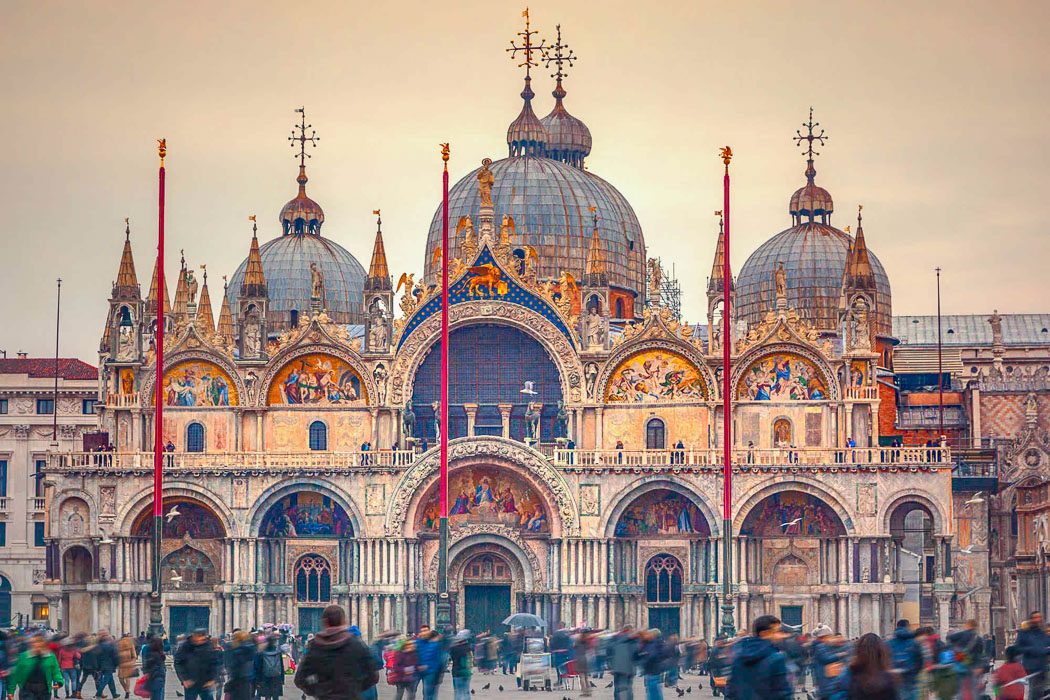
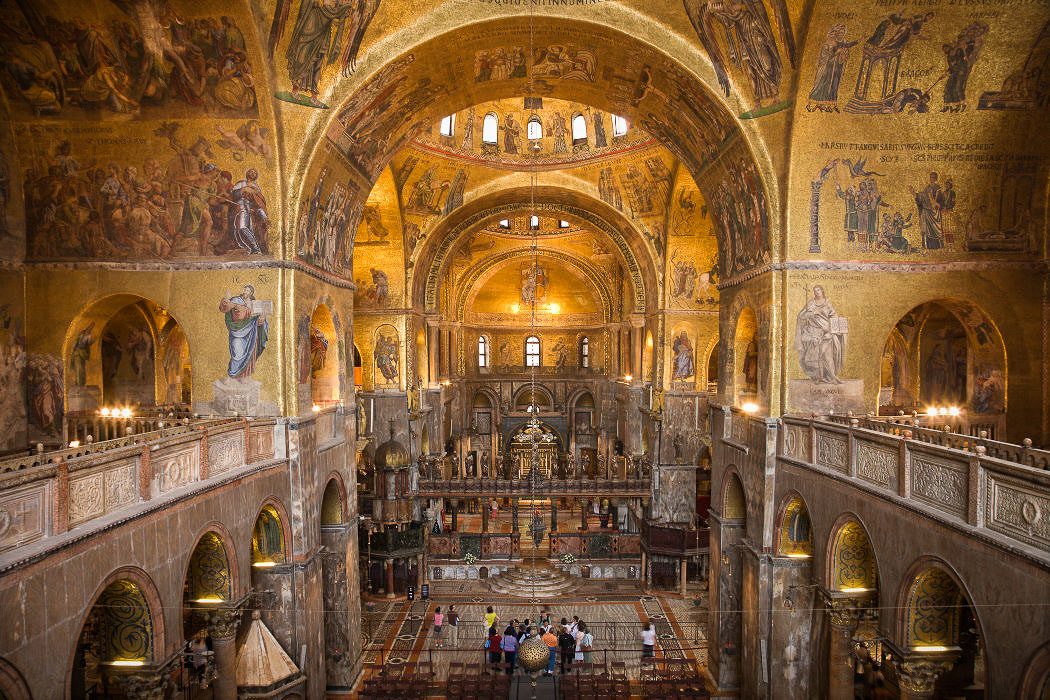
Construction on the cathedral, which is now one of the most impressive buildings in Italy, began almost 1000 years ago.
This basilica is definitely worth a visit: the 8000-square-meter interiors are completely wallpapered with gilded mosaics and precious marble. Similar to St. Peter’s Basilica in Vatican City, which is one of the best attractions in Rome.
Admission to the cathedral is free. However, inside the cathedral there are several parts that charge admission, such as the Cathedral Treasure, the Pala d’Oro, an altarpiece made of gold and gems, and the Saint Mark Museum.
The cathedral is always packed and though the entrance is free, there’s always a line. The same applies to the paid parts of the cathedral. But you can skip the lines with a guided tour and learn a lot of background info at the same time.
Book a guided tour of St. Mark’s Basilica with skip-the-line admission
Or you could visit St. Mark’s Basilica after the ticket office closes. This is possible with a guided tour in the evening:
Guided tour of St. Mark’s Basilica after closing
Our tip: If you want to visit the Doge’s Palace anyway, you could book a combined tour. It’s worth it because the two structures are right next to each other:
Book a guided tour of St. Mark’s Basilica and the Doge’s Palace
free (individual parts are charged for)
St. Mark's Tower
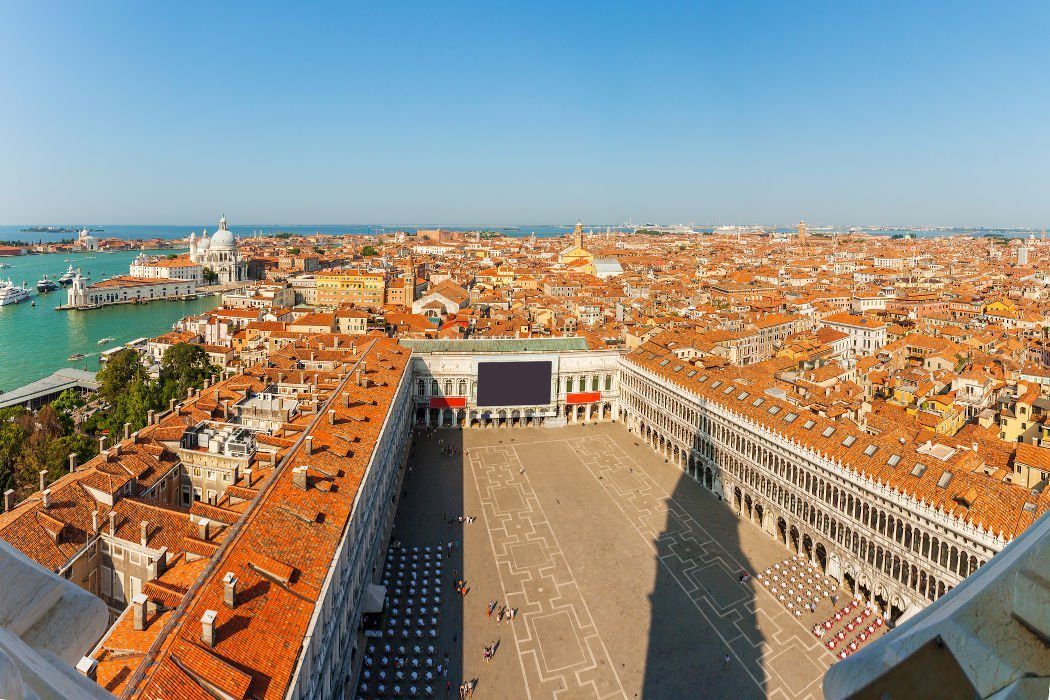
The St. Mark’s Tower is the free-standing bell tower of the cathedral and is even older than the latter: construction began in 888 AD and was originally intended as a lighthouse.
The almost 100 meter high tower has been climbed by several personalities. Galileo Galilei is said to have interpreted the constellation from up here, and Goethe is said to have seen the open sea from here for the first time.
There’s an elevator that takes you to the top. From here you have the best view of Venice and the lagoon: no other building in the city is higher than the St. Mark’s Tower. And if you manage to get to the top on the hour, you’ll be able to hear the bells ringing at close range.
Unfortunately, tickets for the tower are only available on site, so you have to be prepared for waiting times.
Our tip: If possible, come on a weekday, first thing in the morning, when the tower opens. With a little luck, you might even be able to go up right away.
Closed in case of bad weather
10 euros
The Rialto Bridge
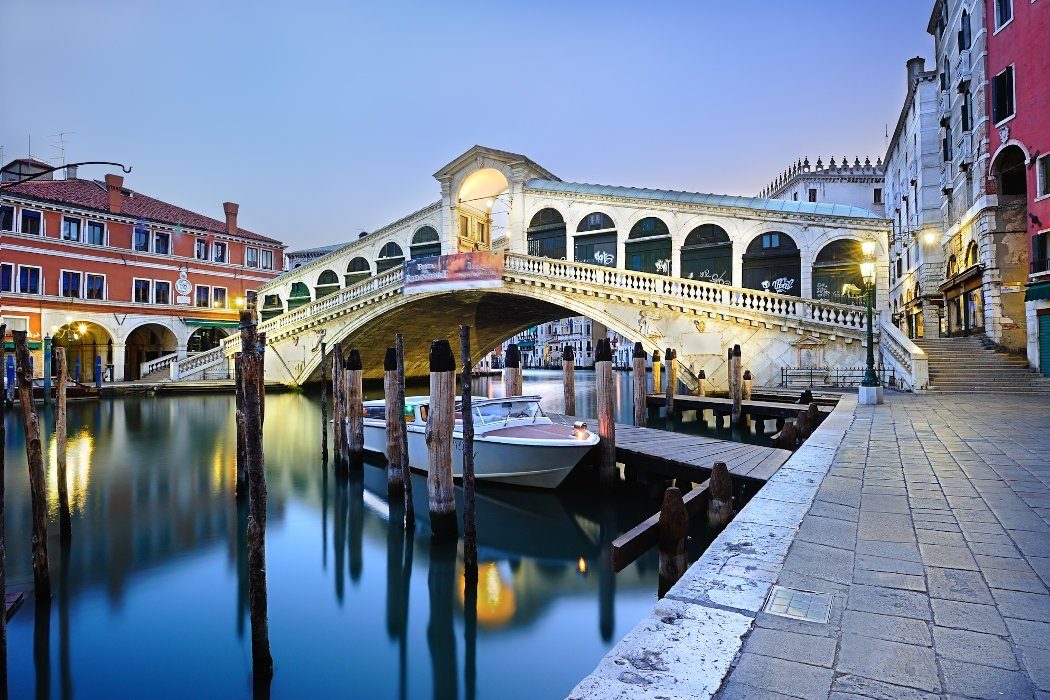
There are a total of 435 bridges in Venice, the most famous of which is the Rialto Bridge. The bridge is featured on every postcard of Venice and is also one of the most photographed Venice landmarks ever.
The stone version has existed since the 16th century. Its 12th century predecessor was made of wood. Its purpose was to bring the citizens to the city market, the Mercato di Rialto, as quickly as possible.
Nowadays, the Rialto Bridge is completely covered and overrun by tourists and street vendors. There are quite a few souvenir stores on it, which is a bit of a shame. Nevertheless, it’s absolutely worth seeing: it offers a beautiful view of the Grand Canal.
Our tip: If you walk along the canal on the Riva del Ferro towards the bridge in the late afternoon, the setting sun falls directly on it. This is the best time and the best location to photograph the bridge!
The Doge's Palace
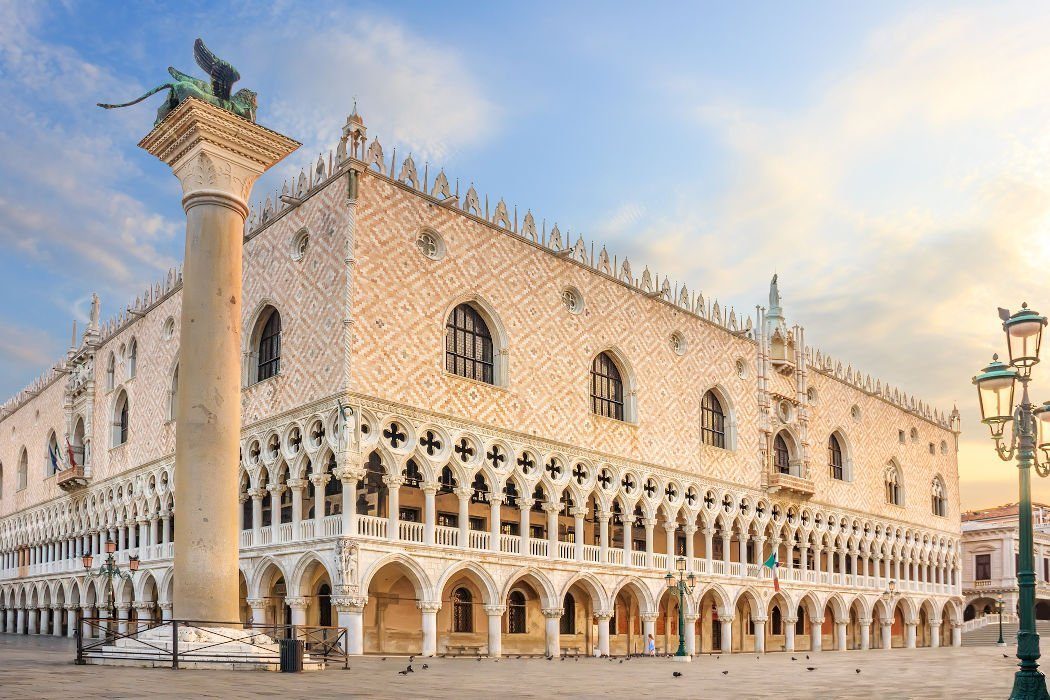
For centuries, the Doge’s Palace was the seat of the Doges, the heads of state of the Republic of Venice.
Because Venice was an autonomous republic as well as a commercial and naval power for over 1000 years. So, from the Doge’s Palace, Venice was a major player in the world economy for centuries.
And like so many sights in Venice, this one is brimming with pomp and circumstance. It borders directly on St. Mark’s Basilica and the Bridge of Sighs, so it’s also right on St. Mark’s Square.
You should make sure to visit the Doge’s Palace from the inside, but there is always a line here as well. So quick entry is definitely worth it for the small surcharge difference, otherwise the waiting times can get very long.
Book a skip-the-line ticket to the Doge’s Palace
Book a skip-the-line ticket to the Doge’s Palace with a 1-hour tour
25 euros
The Bridge of Sighs
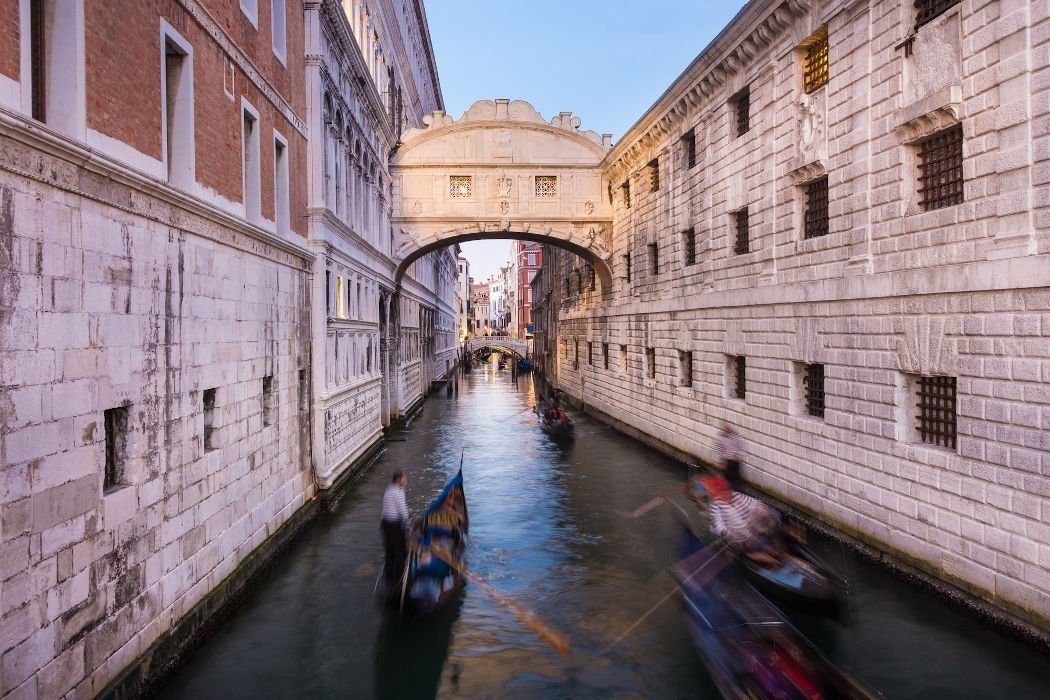
The Bridge of Sighs is another super-photographed sight in Venice. The covered bridge connects the Doge’s Palace with the former prison of Venice.
The name derives from the fact that from here the prisoners condemned in the Doge’s Palace could take a last look at Venice and sigh before they were taken to prison.
The best view of the Bridge of Sighs is from the Ponte della Paglia. This is the bridge that connects the quay of the market square with the bustling Riva degli Schiavoni, a wide promenade of the old town.
The Church of Santa Maria della Salute
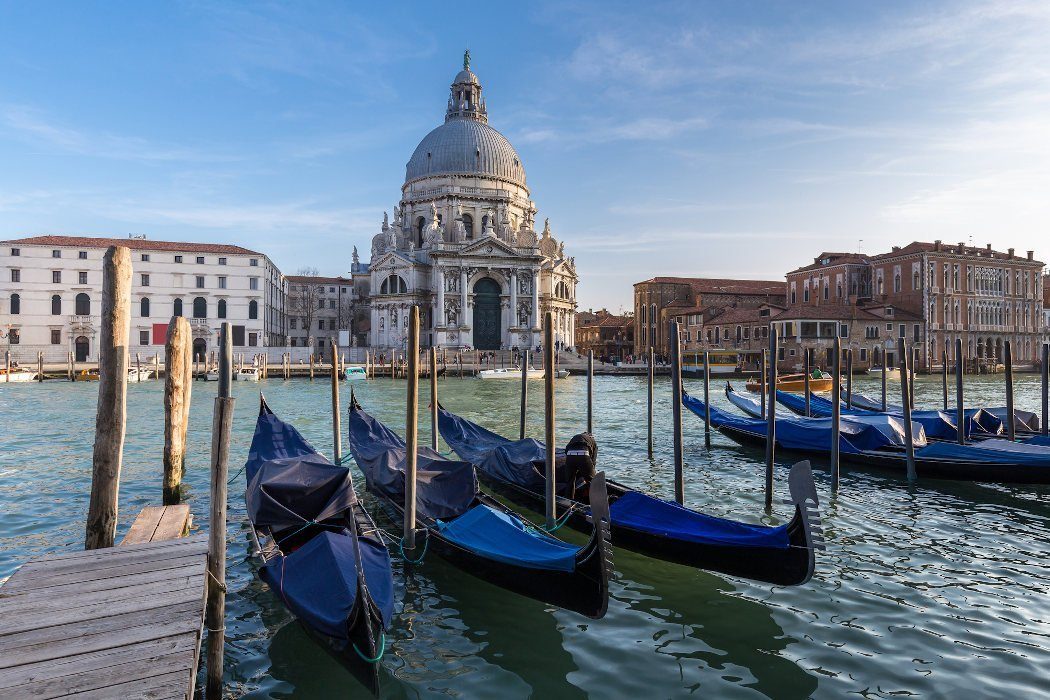
Santa Maria della Salute is definitely the most photogenic church in Venice and a mainstay on countless postcards.
The baroque church with the two striking domes stands directly at the entrance to the Grand Canal.
It was built in the 17th century, when Venice had just fallen victim to the plague. A third of the population was ravaged by the epidemic and the Doge pledged this church to Our Lady in the hope of defeating the plague. The plague had been defeated and so the church became one of the most impressive in the city.
Santa Maria della Salute rests on 10,000 oak piles to keep the structure from sinking.
You can visit it for free.
free
Scala del Bovolo spiral staircase
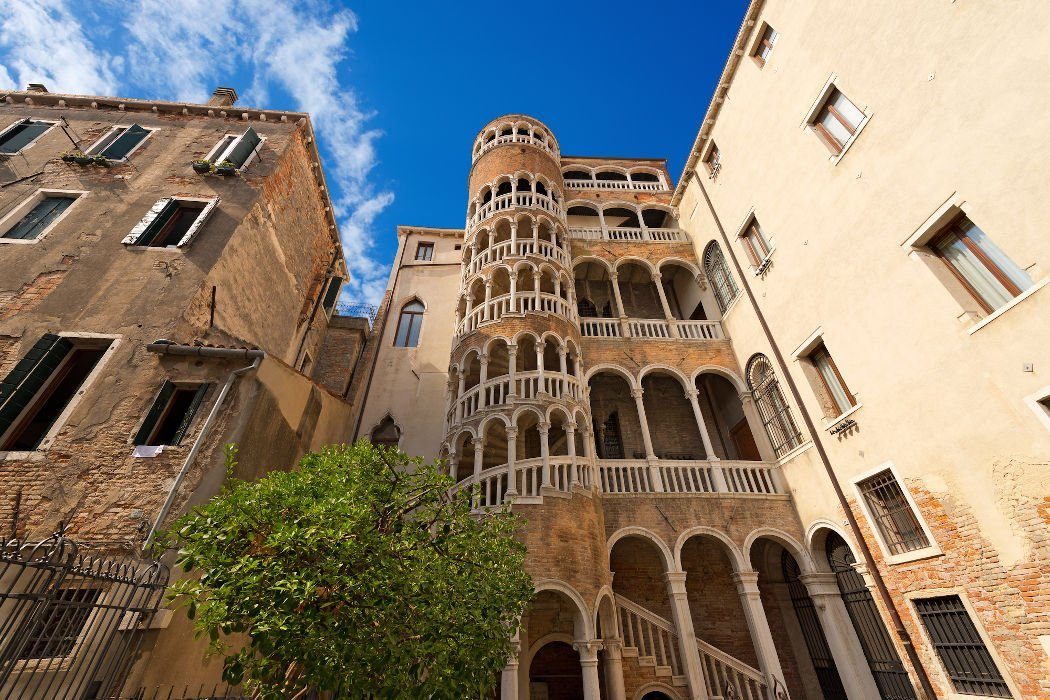
The Scala del Bovolo belongs to the Gothic palace Palazzo Contarini del Bovolo and is located in an unassuming side street near St Mark’s Square.
When the staircase was commissioned in the 15th century, it was designed to be the most beautiful staircase in the world. And beautiful it certainly is!
You can just admire the staircase from the fence, or climb them, which we highly recommend. From the top, you’ll have a great view of the hidden backyards of Venice and St Mark’s Square.
You should definitely book the ticket for the Scala del Bovolo ahead of time to avoid long waiting times. The ticket also includes the art exhibition by Venetian artists in the Sala del Tintoretto, a room on the 2nd floor of the palace.
Book a ticket for Scala del Bovolo
8 euros
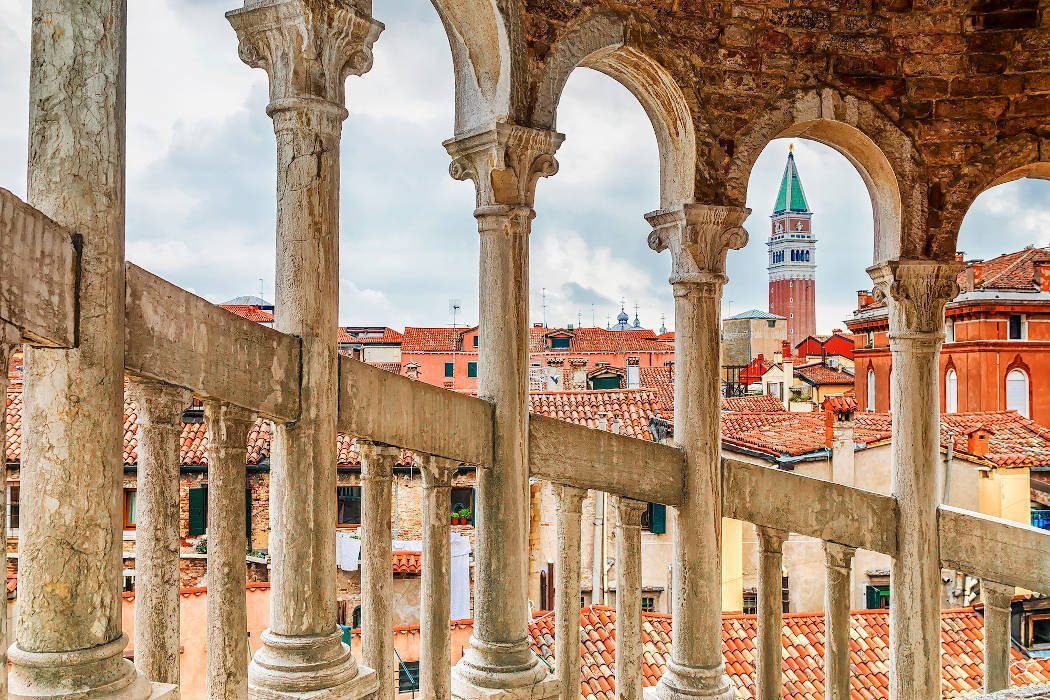
Teatro La Fenice
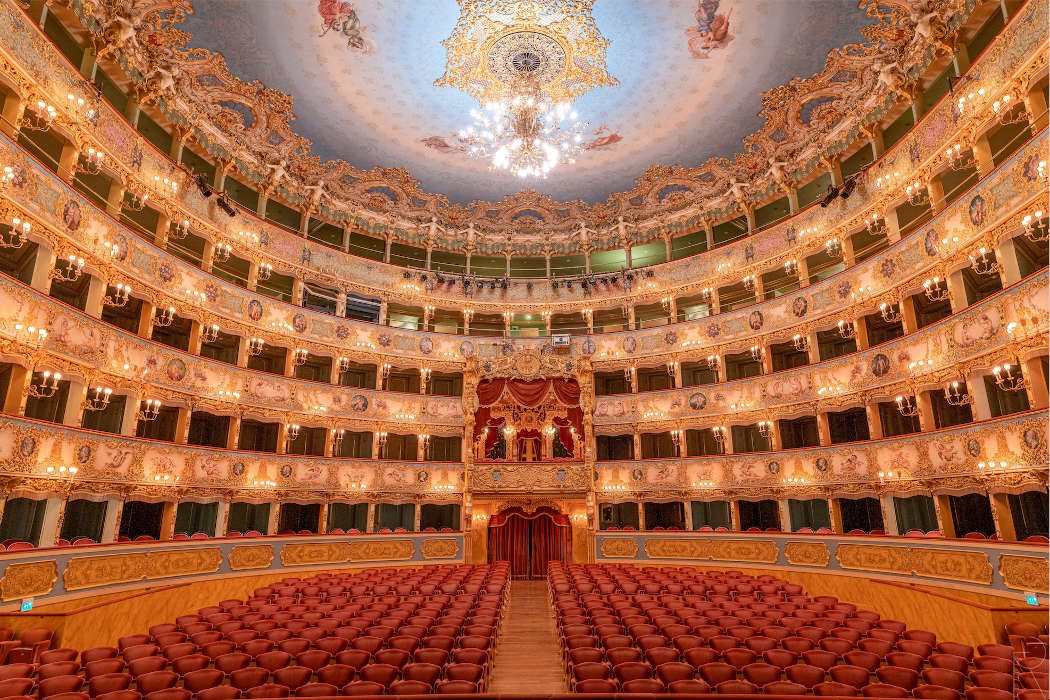
Teatro La Fenice is one of the most famous opera houses in the world. It’s located on the site of the former Theater of San Benedetto, which burned down in the 18th century.
Fenice means phoenix, the bird rising from ashes in mythology, hence the name of the current structure.
The auditorium extends over five floors, and the sumptuous furnishings include red and gold decorated chairs, countless sconces, and magnificent boxes.
You can visit the theatre with or without a performance.
To a ticket with audioguide for the Teatro La Fenice
13 euros (with audioguide)
The Island of Burano
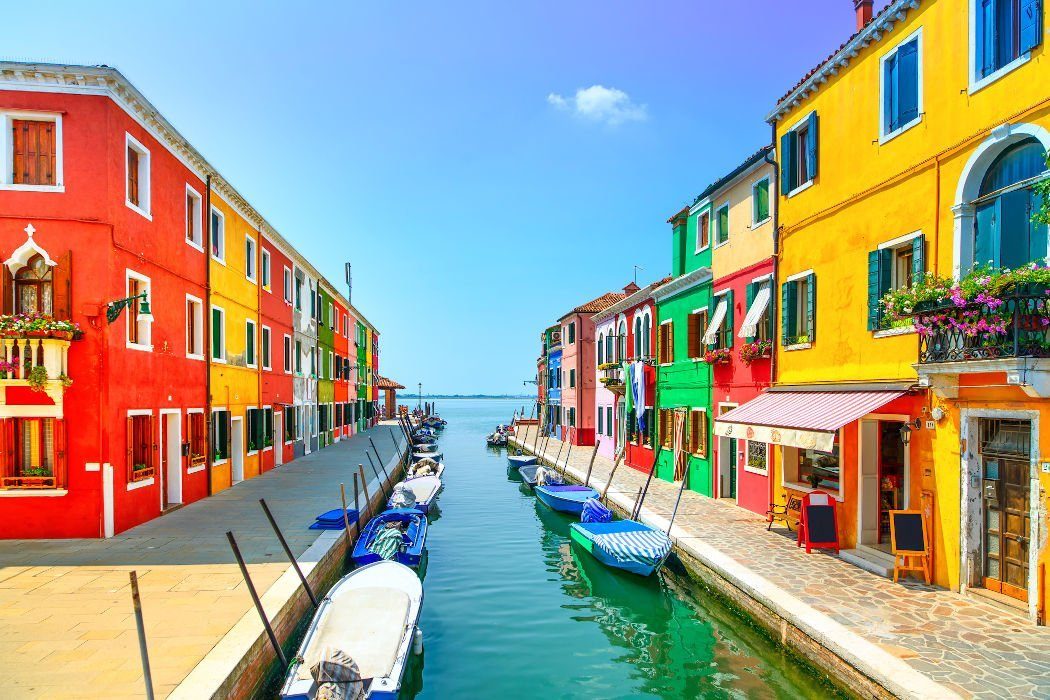
To the northeast of Venice lies the small, colorful island of Burano, which is an essential part of a trip to Venice.
You can easily visit Burano in an afternoon. The island has just 2700 inhabitants and is 45 minutes away by the vaporetto line 12. It’s famous for its charming, colorful houses.
Blue, yellow, purple – no color is too bold for the inhabitants of Burano. It’s said that fishermen used to paint their houses this way so they could spot them even in the thickest fog. Burano is also famous for its intricate lace embroidery, which you can buy everywhere here.
You can also take a guided boat cruise to Burano, which includes the islands of Murano and Torcello. You’ll have 1 to 2 hours free time on each island to look around on your own.
Book a guided tour of Murano, Burano, and Torcello
The Grand Canal
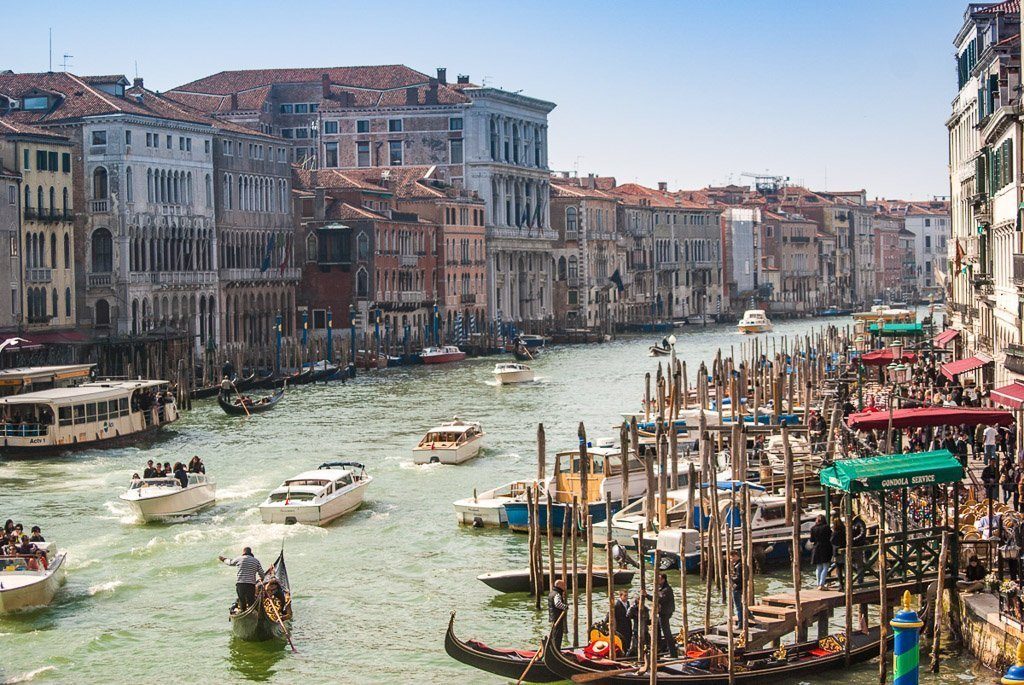
It’s impossible to miss the Grand Canal in Venice. It is the widest of all canals and winds its way through the entire old town.
The canal spans 70 meters at its widest point and is crossed by a total of four bridges, including the Rialto Bridge.
When you arrive in Venice by train and get off at the main station, the Grand Canal is the first thing you see of the city.
There are hundreds of gondolas, motorboats and ferries milling about on the water. You can just sit on a bridge on the Grand Canal forever and watch the hustle and bustle. It never gets boring!
The vacation island of Lido di Venezia
You can also enjoy a real beach vacation in Venice on the island of Lido di Venezia. The island separates the lagoon of Venice from the open sea and has been the vacation spot par excellence since the 19th century.
Lido has everything you would expect at a typical Italian seaside resort: bars, restaurants, clubs, hotels in every price range and, of course, the 12 kilometer-long sandy beach.
Most of the beach costs money: you can rent a changing room, sunbeds, umbrella and chairs for 15 to 20 euros per day. Toilets, showers, and a beach bar are always included. But certain parts of the beach are free of charge, for example the beaches of San Nicolò and Alberoni, located in the north and south of the island respectively.
It takes 30 minutes to get to Lido di Venezia by vaporetto from the Piazzale Roma pier. If you want to stay on Lido di Venezia and use it as your base for your trip to Venice, here’s a selection of hotels in three price ranges:
The Peggy Guggenheim Collection
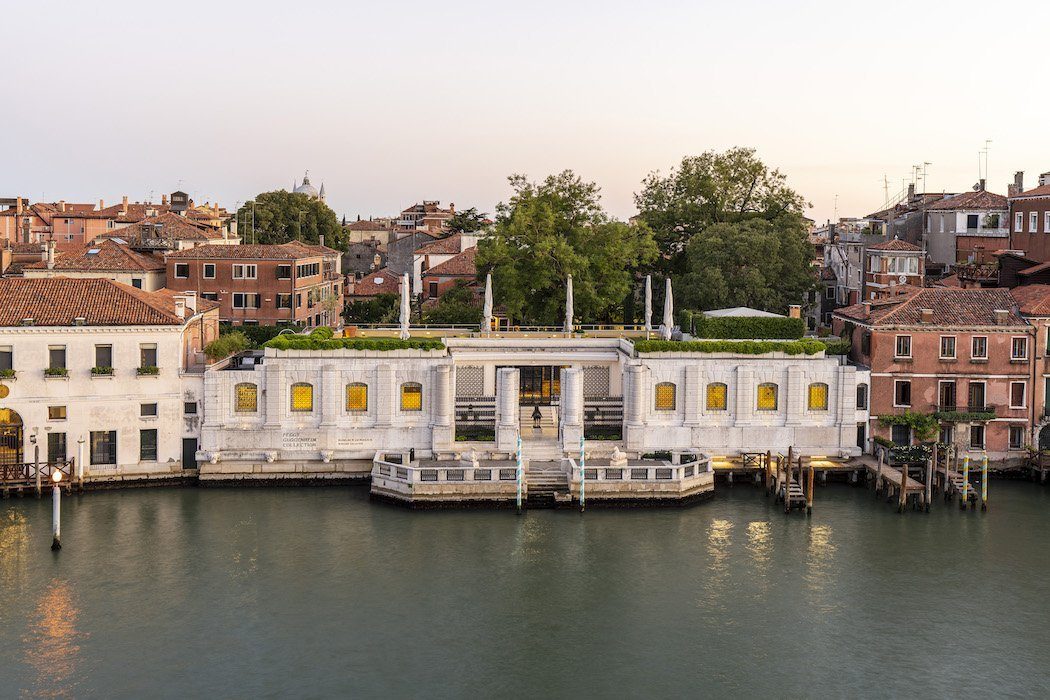
Peggy Guggenheim was an American art collector who made it her mission to create the largest museum of modern art in the 1930s and 1940s.
Even during World War II, she didn’t shy away from the dangers of travel, scouring Europe in search of interesting works of art.
The result is today’s Peggy Guggenheim Collection: the most important Italian museum of modern art, with works by Pollock, Picasso, Kandinsky and Magritte, among others.
The Peggy Guggenheim Collection is located in Venice’s only unfinished building, the Palazzo dei Leoni, on the banks of the Grand Canal.
The museum is one of the most popular Venice attractions, so be sure to book tickets in advance:
Book tickets for the Peggy Guggenheim Collection with fast-track admission
Casino Venier
The Casino Venier is a real Venice insider tip.
Casinos were small, clandestine premises in Venice in the 18th century, where people met after going to the theatre. People danced, gambled, debated, and engaged in all sorts of things that weren’t meant to see the light of day. Of course, not just anyone could enter a casino: only selected members were allowed to enter.
There were a total of 118 of these secret places in Venice, but today only one is perfectly preserved: Casino Venier. It is located in an inconspicuous building. Even the interior decor, the floors and the frescoes are the original ones. Casino Venier consists of three rooms, with secret passages, peepholes and hidden chambers.
Today the Casino Venier belongs to the Alliance Française, an Italian-French cultural institution. If you want to visit the Casino Venier, you have to contact the Alliance Française and ask for an appointment.
Alternatively, the Art Night Venezia takes place once a year in June, when numerous museums and cultural institutions stay open late. The Casino Venier is open free of charge on this day.
The Jewish Quarter
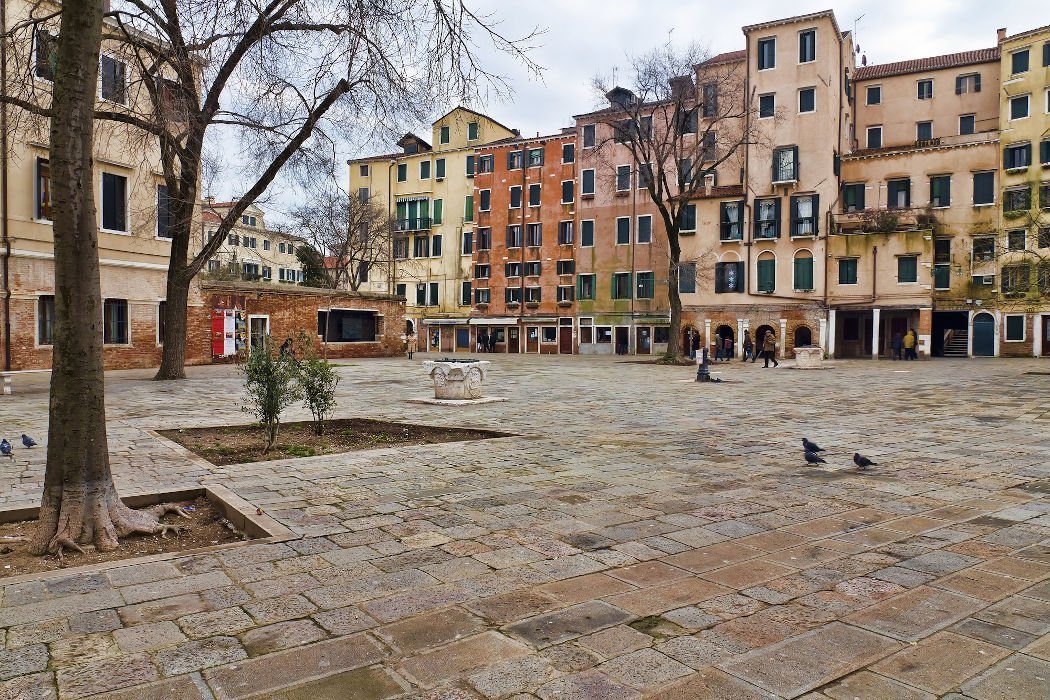
The Jewish ghetto of Venice has existed since the 16th century. At that time, the Jewish merchants were banished to the deserted corner in the northwest of the city to live in isolation from the rest of the republic out of fear of competition.
The term ghetto dates from this period: it was probably derived from the Venetian word geto, meaning foundry. In fact, the neighborhood where the Jews of Venice were to live was the poor neighborhood of the iron founders.
It wasn’t until Napoleon conquered the city at the end of the 18th century that the Venetian Jews were free again. During the fascist period, most of the Jews who still lived in the neighborhood were deported to concentration camps. Today, only about 30 Jews still live in the neighborhood.
However, while it used to be quite run-down, it is now a pretty, quiet neighborhood of Venice. The central square is Campo del Ghetto Novo: here you’ll find three synagogues, restaurants, art galleries and the Jewish Museum.
The neighborhood is much less crowded than the rest of Venice, so you can easily spend a few relaxing hours here.
To a private tour through the Jewish Quarter
Libreria Acqua Alta bookstore
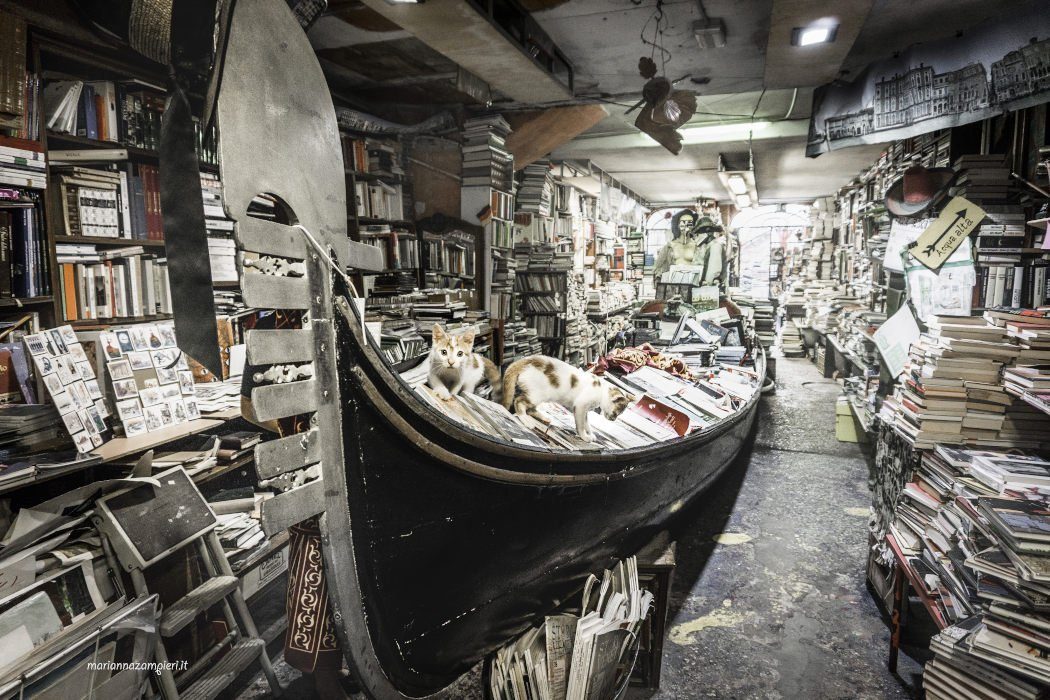
A lesser known, but very noteworthy attraction in Venice is the Libreria Acqua Alta. Translated, the name means high water bookstore and is a very special bookstore in the old town of Venice.
The sign at the entrance claims that it’s the most beautiful bookstore in the world. That’s obviously in the eye of the beholder, but it’s definitely unique.
The books are stacked all around the store, mostly in gondolas and bathtubs. The purpose is that when there is high water, which can happen several times a year in Venice, the books are protected by their floating bases.
The bookstore also has a small courtyard with a staircase made of books and a small terrace on the canal where you can browse through the books.
By the way, the bookstore carries an international selection, so you can also find books in English and many other languages.
Rialto Market
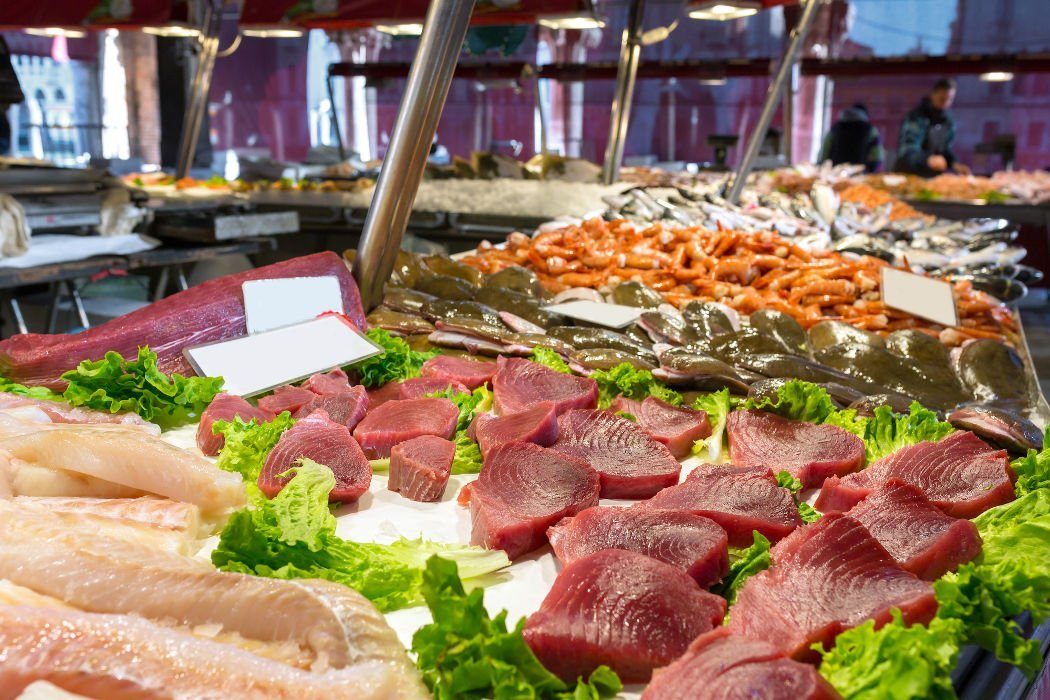
Venice is always full of tourists, but if you want to experience the authentic Venice, you should take a walk through the Mercato di Rialto.
The market has been operating for an incredible 950 years and is the daily meeting place for Venetians from all walks of life: housewives, pensioners, chefs, and merchants. The fish market is especially remarkable: it sets up under a stone balcony and features all the fish and seafood that the Adriatic has to offer.
The market is held from Monday to Saturday until lunchtime. But to experience the real Venetian hustle and bustle you have to come early in the morning between 7 and 9 o’clock, when people are haggling and discussing. After that, the tourists and photographers slowly stream in and the market loses a bit of its authentic flair.
There are many small bars surrounding the market where you can have breakfast with a croissant and cappuccino and mingle with the crowd.
Book a guided street food tour of Rialto Market
Our tip: If you’re self-catering at a vacation rental in Venice, be sure to shop at the Rialto market. Supermarkets are rare in Venice and the prices at the market are about the same as in the supermarket. And the quality is great!
The historic Caffè Florian
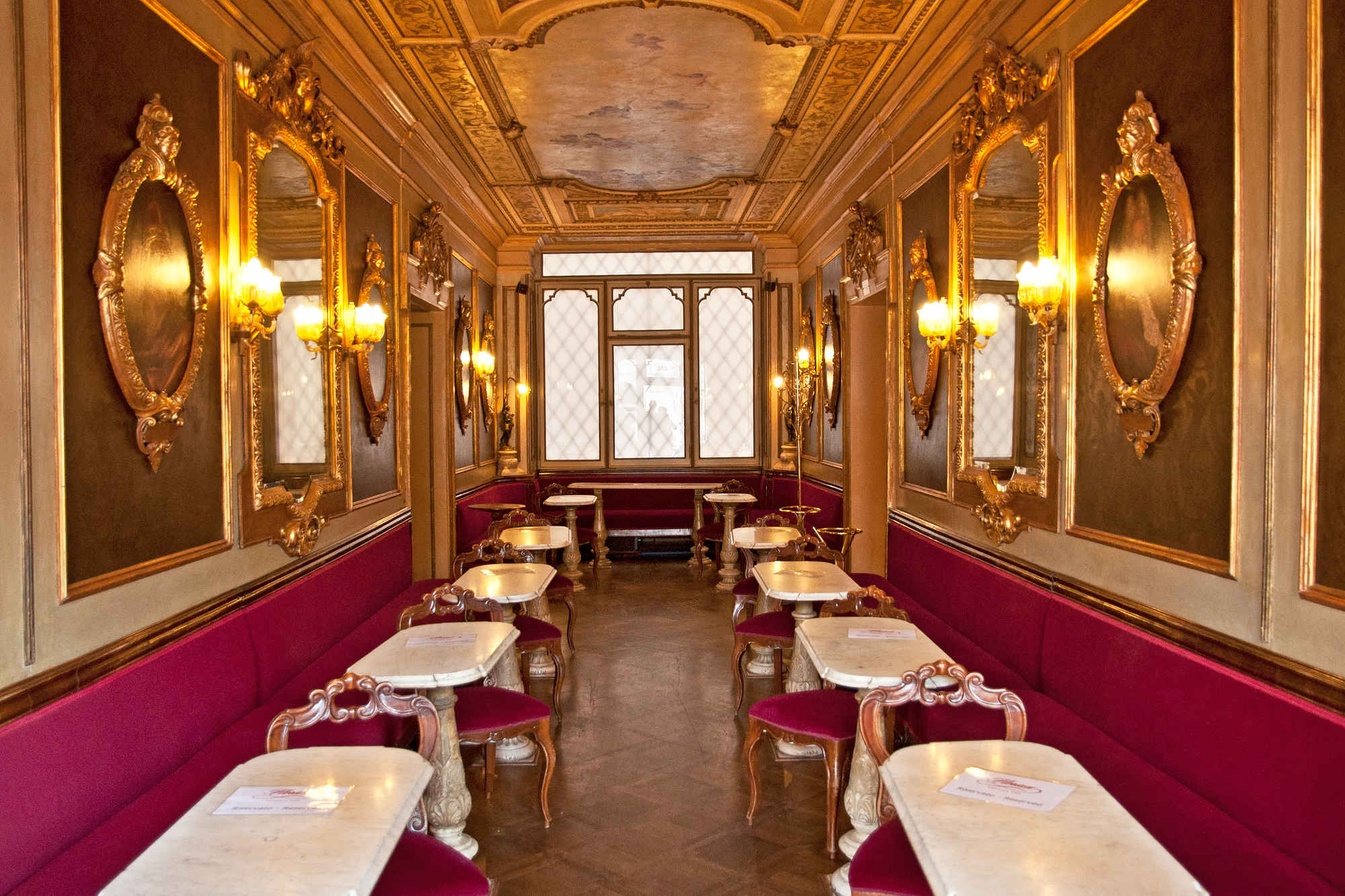
Caffè Florian is definitely one of the must-see places in Venice. It is the oldest coffee house in Italy and a real institution.
It is located directly on St. Mark’s Square, it was opened in 1720 and it even has its own coat of arms.
The interior is a mix of pomp and decadence: gilded stucco, murals and large mirrors, combined with faded colors, characterize the cafe’s wood-paneled rooms.
While Venice’s nobles and intellectuals used to meet here, today it’s mostly tourists. Nevertheless, the café has an incredible charm and is definitely worth a visit.
However, the café isn’t just famous for its extravagant decor, but also for its opulent prices: A cappuccino on the terrace costs around 10 euros, plus a couple extra when there’s a pianist playing. But if you drink your coffee standing up at the counter, the prices are considerable more reasonable and you can still take a look inside.
free
The mask workshops
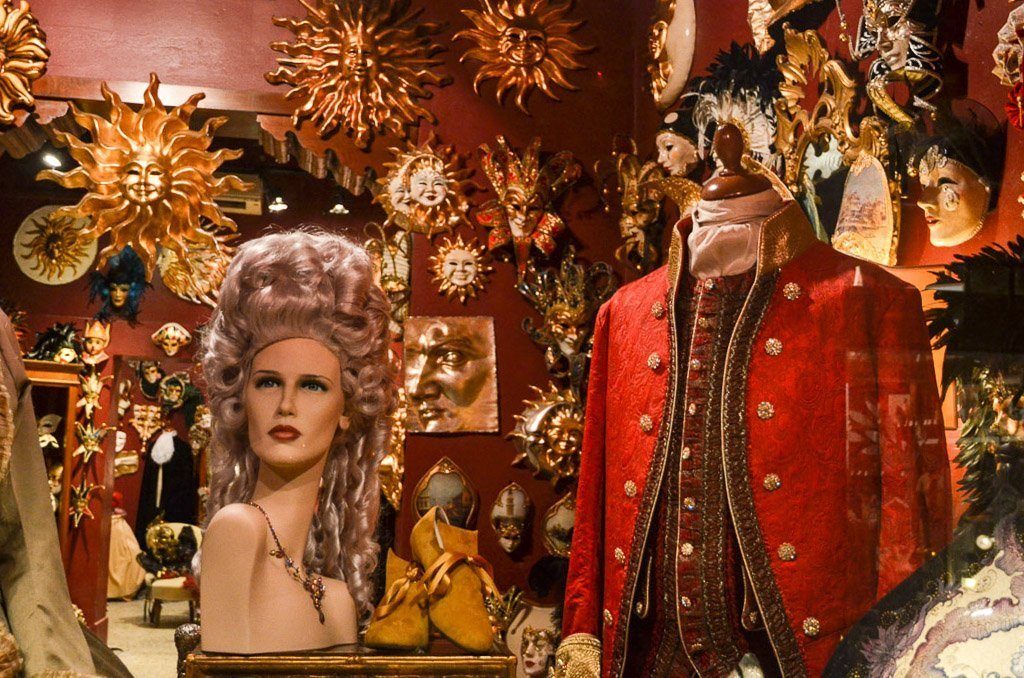
Of course the capital of carnival has many mask workshops. The famous Venetian masks are crafted by hand here and sold directly in the associated store.
One of the most famous workshops is Ca’ Macana, whose imaginative masks have been used in the Hollywood movies Eyes Wide Shut and 50 Shades of Grey.
So when you visit one of Venice’s many mask and costume boutiques, you can do some shopping while looking over the shoulders of the artisans – or even create your own mask: Some studios offer 1-2 hour workshops where you create your own mask – a really great activity in Venice.
Book a workshop at a Venetian mask atelier
Venice Carneval
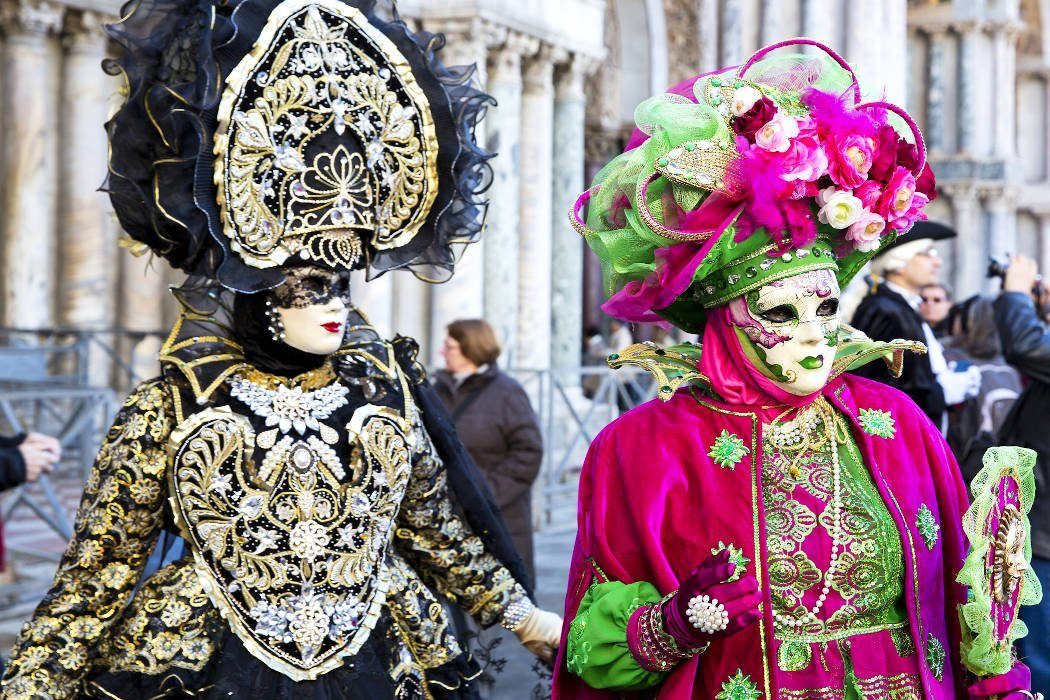
The Venice Carnival is the highlight of the year in the lagoon city.
Exactly 10 days before Ash Wednesday, it starts with a big opening ceremony, where an acrobat dressed as an angel floats down from St. Mark’s Tower to St. Mark’s Square. This day also sees the historic boat parade on the Grand Canal, with around 120 gondolas with costumed boaters and much fanfare passing cheering spectators.
In the following days, Venice’s streets are abuzz with music, stage plays, puppet shows, and street performers. The masks and costumes from the 18th century are quite traditional, with sweeping ball gowns and colorful headdresses. Most of them are handmade and are worth a few thousand euros. You can also rent them by the day and join the parade!
The Venice Carnival is an event absolutely worth seeing, even if it gets incredibly crowded. Especially on the weekend leading up to Ash Wednesday, the city is filled with day-trippers from the surrounding countryside and the rest of Italy.
Our tip: If you are in Venice already a few days before the official start of the Carnival season, it’s not so crowded yet and you’ll still get to see a few costumes already.
One more tip: Make sure to try a frittella during carnival season! This is the traditional carnival pastry with chocolate or cream filling that you can get in any café.
A gondola ride
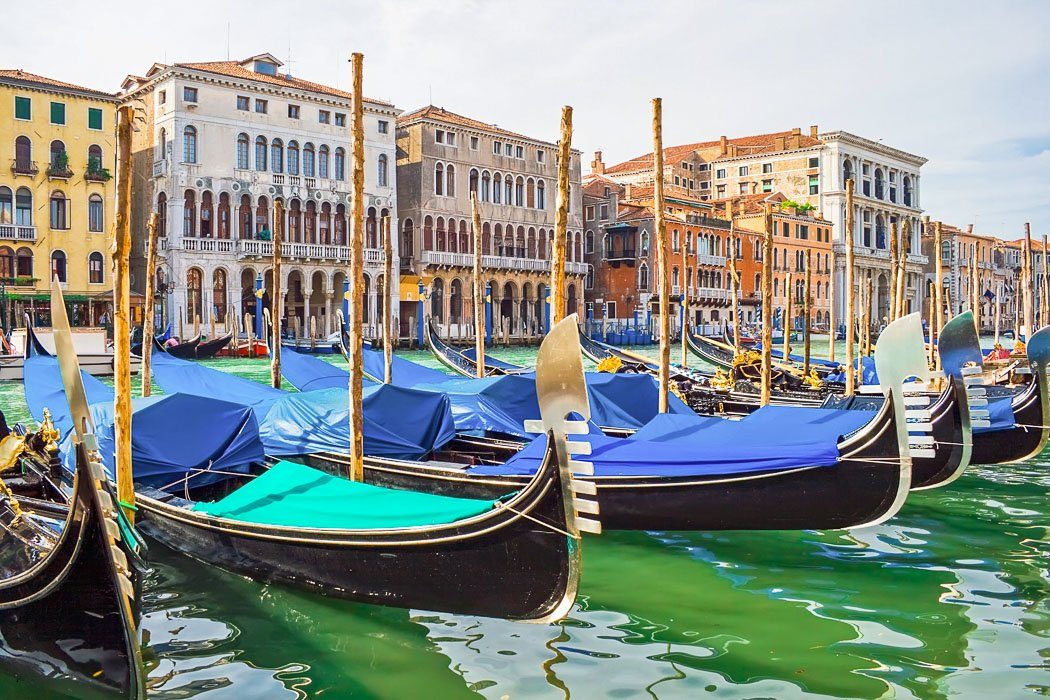
The classic Venice highlight is a ride in a gondola. Everywhere on the Grand Canal and in the smaller canals of the old town you will constantly see a gondola with tourists who let themselves be cruised through the canals.
But before you head to the next dock, there are some details you should know beforehand:
- A gondola ride is quite expensive. The standard price for a 30-minute ride is 80-100 euros per gondola. It can be even more expensive in the late afternoon and evening, as these are the most popular times for tourists to ride.
- A gondola can fit up to ten people. If you want to pay a little less, you can also share your gondola. But of course that isn’t quite as romantic.
- The gondolier, i.e. the gondola guide, can also tell you a bit about Venice. Or rant about Italian politics, or have private conversations on his cell phone. Or even remain silent. In any case, it’s not a guided tour with singing like in the movies. But most gondoliers are very nice and talkative.
- In the narrow canals of the old town it can get congested from time to time. To avoid this, you should either take a gondola ride on the Grand Canal, or take a gondola in a more remote part of the Old Town. The further away from St. Mark’s Square, the better.
You can also book a gondola ride in advance online. This is especially practical in the peak season, because then lines at the piers are not uncommon.
Book a private gondola ride for up to 5 people
Book a shared gondola ride for up to 10 people
Eat cicchetti
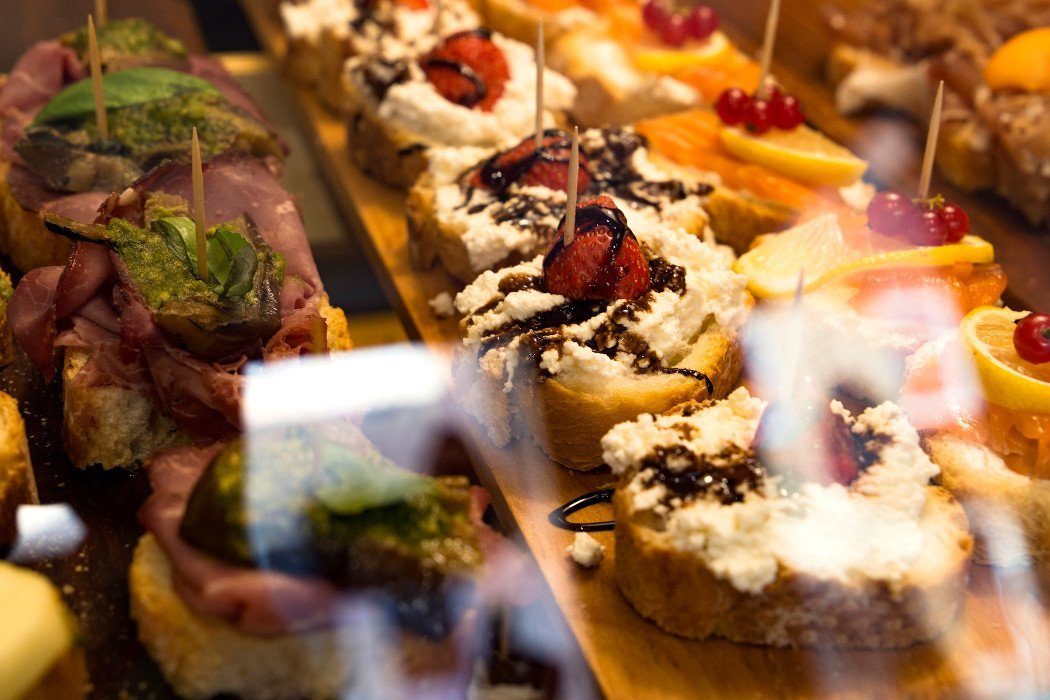
A cicchetto is the Venetian answer to Spanish tapas and is as much a part of Venice as St. Mark’s Square.
These are mainly small slices of white bread with all kinds of toppings, such as grilled eggplant, pistachio cream cheese, olive paste, prawns with garlic or sun-dried tomatoes with mortadella. And and and – the imagination knows no bounds!
The traditional place to get cicchetti is a bacaro. These are tiny little places, usually consisting of just a counter and a few tables, scattered all over Venice.
The best way to enjoy cicchetti in true Venetian style is on a plate on the banks of the canal, accompanied, of course, by an ombra, the Venetian expression for a glass of wine. Be sure to do it!
To a Venetian night flavors tour with different cicchetti and ombre
General tips for sightseeing in Venice
But before you get started with your Venice trip, here are a few tips to help you prepare for your trip.
#1 Book a hotel in the old town of Venice
The old town is the area that you see in all the photos of Venice with the canals and the gondolas.
You should make sure to stay here as well, because this is where most of the Venice attractions are located. Of course, there are other, more modern parts of Venice, partly on islands, partly on the mainland.
Hotels in Venice’s historic center aren’t cheap, but you’ll save yourself the boat ride you’d otherwise have to take every day for your sightseeing.
Here come a few hotels for every budget that are strategically located:
#2 Book your accommodation in Venice early
You should book as far in advance as possible to get a place to stay in the old town.
That won’t save you any money, unfortunately, because even 1-star hotels or simple guesthouses rarely offer rooms for less than 100 euros a night, no matter if you book a month or a year in advance.
But if you plan your trip to Venice on short notice, you might be left with only the luxury rooms for 400 euros per night.
#3 Take a guided tour of the Venice sights
Given the abundance of highlights in Venice, a guided tour of the city is not a bad idea.
Especially if you only have limited time and want to see as much as possible. These tours are all in English and are particularly suitable for a first impression:
2-hour guided tour of Venice
2-hour guided tour and gondola ride
But even if you’re staying for longer or already know your way around Venice, there are some interesting tours that are a bit more unique:
Legends and ghosts tour through the old town
#4 Visit the Venice attractions in the off season
Venice is never really empty. But in the months of November, January and March, at least you don’t have to wait in line for a long time in front of the sights and the alleys aren’t as crowded.
What’s more, you can score some real bargains on hotel bookings in the off-season: For example, in November you can get a 4-star hotel in the old town for as little as 150 euros a night. By comparison, the same hotel costs more than twice as much in the high season.
Of course, the weather isn’t quite as nice in the off season. But hey, it’s still Italy: with a little luck you’ll still catch some sun!
Those were our 22 most beautiful Venice sights
Have you been to Venice and can you contribute more highlights? Then we look forward to hearing from you in the comments!
